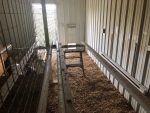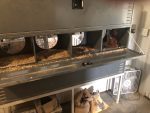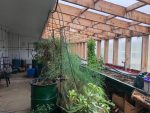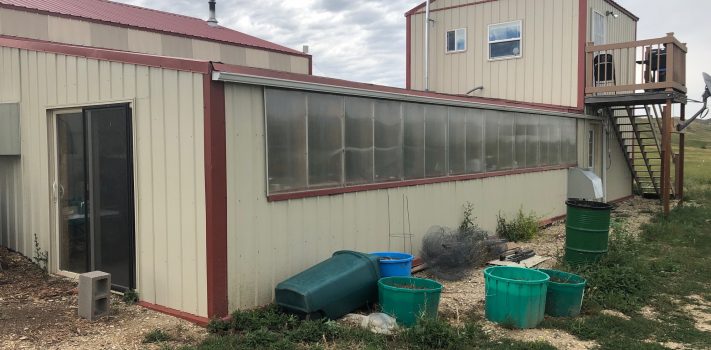We moved to the American Redoubt five years ago, from Northern California. We wanted something located away from any big cities, with some acreage, well water, a septic system, a big shop, and with wild game. While surfing the net for real estate which would be suitable for long term sustainability after a SHTF event, I found a listing of a property with a description of amenities that sounded ideal. In fact, on the way to see the property with our Realtor I commented to my wife that it really sounded too good to be true.
Included in the description was: “Five year old 2,700 s.f. well insulated, one level home situated on 80 fenced acres, adjacent to 640 acres of State land with mule deer and antelope, year around creek with 5 acre pond, a detached 36′ x 36′ shop, private well and septic system, all located in the country, two hours by car from any highly populated areas.”
As it turned out, everything was as described, much to our surprise and joy. The only thing I would have preferred was a smaller house for the two of us. We had had large homes in the past when our family was growing but now our needs were for less. Even that “excess” turned out to be a blessing as I will explain.
The shop was not insulated or sheet rocked, so that was of highest priority, as I planned to spend long, cold winters in the shop enjoying my hobby as a metal fabricator. Just prior to the work beginning I had an insulated chimney installed for a wood stove. The walls were framed with 2×4 studs providing only room for R-11 batt insulation. The insulation contractor suggested spray-on foam insulation which has a much higher R value, and so we went with that and I am very glad that we did! That stuff not only insulates but it seals everything so that no air can penetrate cracks between the studs, et cetera. The next priority was a chicken coop. The shop has covered “wings” on each side for hay storage, etc. We had one side closed in, insulated it and poured a concrete slab. I fabricated a salvaged gym locker installed horizontally to serve as a nesting area with opening to the next room so eggs could be gathered without entering the hen house. I also fabricated a “guillotine” door operated from the next room with a winch and cable to open and close the door to let the chickens outside to “free range”.
The next priority was a chicken coop. The shop has covered “wings” on each side for hay storage, etc. We had one side closed in, insulated it and poured a concrete slab. I fabricated a salvaged gym locker installed horizontally to serve as a nesting area with opening to the next room so eggs could be gathered without entering the hen house. I also fabricated a “guillotine” door operated from the next room with a winch and cable to open and close the door to let the chickens outside to “free range”.
 can access the greenhouse through the shop and chicken coop. This allows me to heat the shop and chicken coop with excess heat from the greenhouse during the day. By installing a light on a timer we can provide light during the short days of winter so that the light and the heat prevent the chickens from molting. Hence, we get beautiful eggs, year around.
can access the greenhouse through the shop and chicken coop. This allows me to heat the shop and chicken coop with excess heat from the greenhouse during the day. By installing a light on a timer we can provide light during the short days of winter so that the light and the heat prevent the chickens from molting. Hence, we get beautiful eggs, year around.
Adding The Greenhouse
The next improvement was to build the winter greenhouse. Most family greenhouses are only used in the spring to get a head start on growing seedlings and in the fall to extend the growing season. They are typically heated only passively by the sun. This works very well, even in the dead of winter, during the day. Night, however, is another story in our zone 4 climate, requiring an additional heat source. My goal was to grow vine-ripened, heirloom tomatoes year around. So, in the 16′ x 16′ “utility room” next to the greenhouse, I installed a 1000 gallon plastic water tank. I built a “rocket stove” water heater to circulate and heat the water in the tank.
When we poured the concrete slab for the greenhouse floor we installed pex piping for radiant heat. I also installed a propane fired “instant” water heater as a backup to heat the water in the tank. Last winter was exceptionally cold but the greenhouse never dropped below 45 degrees Fahrenheit at night. The sun kept it in the 70s and 80s in the daytime. I burned approximately $300 worth of propane that winter which was worth it to get delicious tomatoes and other vegetables throughout winter. However, that was not where I wanted to be in terms of sustainability. But more about that later. Stay tuned ’cause it gets very interesting.
The greenhouse itself is 16′ x 36′, not huge but big enough to keep a good sized family in vegetables year around if managed properly. I did a lot of research before starting to build but, quite frankly, I was not sure I could achieve my goal. I did not want to spend a lot of money on engineering fees so I designed it myself. The main key is to face the plastic dual glazed windows to the South with the North wall solid and insulated. The east wall (the wall to the utility room) is solid and insulated. The west wall is mostly a sliding dual pane door. This captures the evening sun. The South half of the ceiling is dual glazed plastic and the North half is solid and insulated.
Most people recommend slanting the South wall at an angle that captures maximum heat from the sun. However, I did not want to lose the “headroom” on that side so we built that wall vertically. This turned out to be a good decision as there is plenty of heat from the sun during the day. I should add that only the upper half of the South wall is open to the sun with the lower half solid and insulated. This design works great! As the low-in-the-sky winter sun crosses from East to West, the greenhouse captures a great deal of sun heat and light.
Truly Year-Round
Originally, I thought that I would only be able to grow in the winter as I thought it would be too hot inside during the summer. However, I was pleasantly surprise to find that since the summer sun moves so far to the north that the north half of the roof (solid and insulated) provides enough shade that I can grow inside even in the hottest part of the summer! It helps that I installed an automatic exhaust fan at one end of the greenhouse with an intake vent at the other end. I also installed a small “swamp” cooler which allows me to grow cooler-loving greens like lettuce and chard year around.
So, I proved to myself that it is entirely possible to raise vegetables year around in an area with a very cold winter climate. A pleasant bonus is that many annual plants will keep producing year around and from year to year when they don’t have to experience the winter cold. I have tomato plants that have been producing continuously for 2 ½ years! It is also feasible to produce a large volume of micro greens for sale through the winter in a small area of the greenhouse. I have not done so but a winter greenhouse provides the environment to provide some income if someone wanted to. I should ad that everything I have grown has been in soil, or actually in compost. No bland, tasteless hydroponic tomatoes for me!
 Now, for the really good part! As I mentioned previously, we have been dependent on fossil fuel (propane) for supplementary greenhouse heat on cold, winter nights. The rocket stove, while being very efficient, requires almost continuous feeding of wood fuel. So I am now installing a micro hydro generator and electrical line from the generator to the greenhouse utility room. This will provide electricity to water heater resistance elements to heat the water in the 1000 gallon tank previously mentioned. We have approximately 500 gpm water flow but only 8′ of head, so the system we are installing is designed for a low head, high flow situation. It isn’t a large system, but unlike solar, it will produce electricity 24 hrs/day. Any excess power will charge a battery bank for other uses. Since there will be no requirement for electricity for heating in the summer, the excess electricity will be used for running the swamp cooler and exhaust fan and whatever? Maybe by adding a little solar we can become totally energy independent. Wouldn’t that be nice!
Now, for the really good part! As I mentioned previously, we have been dependent on fossil fuel (propane) for supplementary greenhouse heat on cold, winter nights. The rocket stove, while being very efficient, requires almost continuous feeding of wood fuel. So I am now installing a micro hydro generator and electrical line from the generator to the greenhouse utility room. This will provide electricity to water heater resistance elements to heat the water in the 1000 gallon tank previously mentioned. We have approximately 500 gpm water flow but only 8′ of head, so the system we are installing is designed for a low head, high flow situation. It isn’t a large system, but unlike solar, it will produce electricity 24 hrs/day. Any excess power will charge a battery bank for other uses. Since there will be no requirement for electricity for heating in the summer, the excess electricity will be used for running the swamp cooler and exhaust fan and whatever? Maybe by adding a little solar we can become totally energy independent. Wouldn’t that be nice!
Water
In addition to our private well I have set up a rain water collection system which collects water from the gutter on the greenhouse and stores it in a 65 gallon plastic tank. Even in our arid climate we have never drawn the tank below half full! While our well water is potable it contains a lot of minerals and sodium. Since I have a sodium restricted diet I prefer drinking the pure rain water. Plus, in a grid down situation it may be difficult to pump the deep well water. I run the rain water through a Berkey water filter providing us with outstanding drinking water!
As a final note, I mentioned earlier that we really didn’t need such a large house. While building the 16′ x 16′ utility room adjacent to the greenhouse, I decided to put a second story on it for a Tiny House. We have since moved in and are loving it! 256 s.f. doesn’t sound like much room but by maximizing the utility of every s.f. it can be very comfortable! We have a small dishwasher, washer/dryer combo, air conditioner, double cook top, convection oven, microwave oven, double bunk bed (extra long), and a bathroom with full shower. We plan to rent the big house to provide some retirement income — an additional blessing!
We have not prepared for a nuclear fallout scenario, IE. no bunker, etc. We have decided that we would rather not survive in such a world. We also have no Bug Out plan since we will not bug out for any reason. At 72 years of age we have no desire to be refugees! If the Schumer never Hits the Fan, we will have truly enjoyed living where and how we now live. My only regret is that we didn’t move here sooner! If the S. does HTF, then we are ready.











Very nice and informative writing.
Nice article. I’m not clear on what you meant by “We have approximately 500 gpm water flow but only 8′ of head, so the system we are installing is designed for a low head, high flow situation.” What is the 8 ft of head?
Putting prices to the projects would be nice. Granted I know price varies but a ballpark would be nice to know.
Thanks for the article.
Head is the amount of drop between the point of diversion/collection and the outlet. More head means more force/pressure on the turbine.
Bravo for you guys! Sounds like you have set yourselves up well. Thanks for the inspiration!
Good article. This is the type of property I am searching for right now with live water and an on grid preference. I check Survival Realty regularly.
As far as bugging out …… I am the same age as the writer and bugging out would be dicey. As a friend said recently, when the SHTF I plan to ‘die in my doorway’. (I think it is a catchy phrase worth maintaining).
One of the problems with winter greenhouses is weak sun. It’s the same problem that seed starters run into in the springtime if they have cloudy weather.
A trick that I have seen is to build lighting reflector boxes behind the seed trays to bounce the available light back at the seedlings and increase the available light. The same method is used by commercial growers in indoor growing by applying reflective material to the vertical surfaces in the growing area. “Panda Film” is a brand name of a material that’s purpose built for this but is relatively expensive. I’ve had good results using cheap mylar space blankets ordered in bulk from Amazon and taped up on the walls. In the greenhouse pictured, these could maybe be taped to a tarp placed behind the plants (in relation to the windows) for the winter time. It should help increase yields.
Gregory
He is talking about installing a hydro electric system, probably on a creek or the outflow of his pond that produces electric power. 500 gallons of water a minute that drops 8 feet into a turbine.
You mmust be right, Montana Rancher. It does sound like ‘creek flow’ GPM, plus the use of a term >often used for water-pumps. Feet of head is used to describe the lifting power of a pump (There could be valve and line resistance loses).
Wikipedia has an article about ~Hydraulic head~ to help explain the lifting power of water, (at least on Earth).
The term ‘pump’ can be an electric pump, windmill powered pump, or a device used to harness the power of falling/flowing water.
It’s a good article; explaining the creation of what T.M.P. wants and needs. = “I also fabricated a “guillotine” door operated from the next room with a winch and cable to open and close the door to let the chickens outside to “free range”.
The two story house takes advantage of another attribute of the Earth. = Warm air rises. The Tiny House becomes more energy efficient, than the same square footage in a one story home.
Montana Rancher
Your correct. I ran a 6″ water line from my pond to two small turbines I purchased from Spencer Langston of Langston Alternative Power.(http://www.langstonsalternativepower.com) There is a great deal of information on his website regarding the two main requirements for microhydro power, flow and head.
Nice article and thanks for the photos. I especially liked the clever reuse of the gym lockers for collecting the eggs.
Since you mentioned nuclear fallout, I can’t help but provide a different perspective. In your location away from major cities, you will not die from fallout. But you will suffer from radiation sickness, which is easily preventable. Cresson Kearney’s book covers this well in Chapter One, which is available free from the SurvivalBlog reference library. You will survive, so think about that, or not. YMMV.
Great article….best of luck to you.
An easy way to think of head is an 8 foot waterfall has 8 feet of head pressure. The gravitational pull on water stored in an elevated tank allows that potential energy to do work if harnessed.